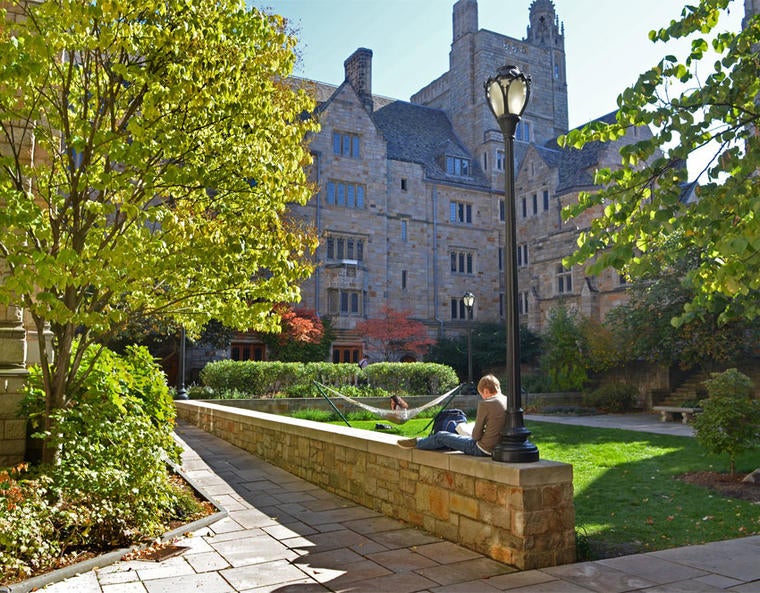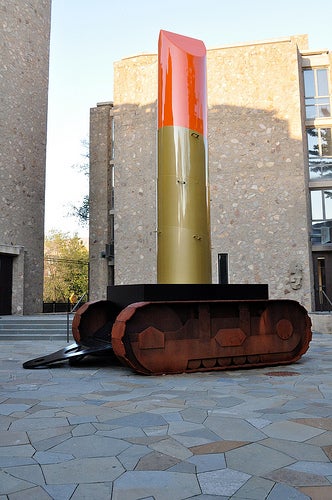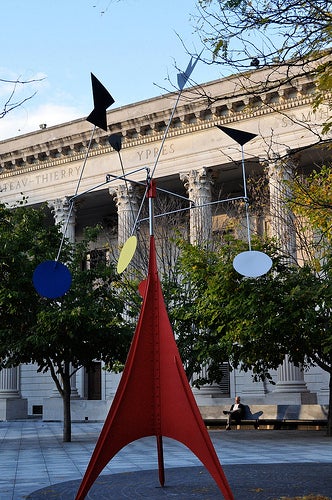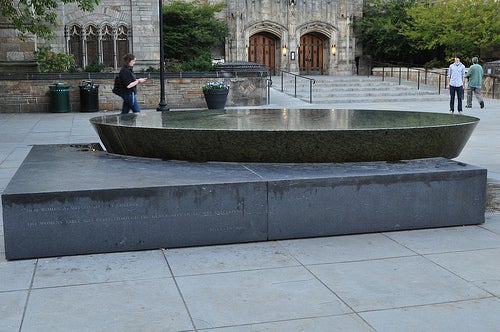
If someone had asked me what I thought about the art and architecture here at Yale before I arrived on campus, I would have described the iconic images of Yale that many people are familiar with: The neo-Gothic architecture, the famous paintings in the Yale University Art Gallery, and the well-known bronze statues on Old Campus.
Now that I’m here, though, I’ve realized that there is so much more to public art at Yale. Being around the traditional art and architecture that is ubiquitous at Yale is an amazing experience. But my favorite artworks on campus are those that are not as well known: they’re a little more contemporary, sometimes whimsical, and often times just as provocative and steeped in history as the older monuments that surround them.
One of my favorites is the Lipstick Sculpture, which is housed in Morse College. Whenever I happen to be in Morse, whether grabbing a meal or running to a meeting, it is always the first thing that I notice. First installed in 1969, it’s imposing and outrageous - even today amidst Morse’s modernist architecture, it strikes a huge contrast with its environment. Although students now see the lighter, humorous side of the Lipstick Sculpture, its creation was quite a rebellious statement in the politically charged atmosphere of the 1960s.

Interestingly, the sculpture was originally placed out on Beinecke Plaza –envisioned as a platform for public speaking. I can only imagine the tone its bright color and confrontational design would set for a speaker among the cream Greek columns and white marble of the quad (below).
The most fascinating part about the Lipstick Sculpture to me is how it has become another tradition at Yale. When it was first made, it was done up with a vinyl balloon tip and plywood tracks – when it was refurbished, it was made much sturdier with aluminum, fiberglass, and steel structure. To me, it’s a symbol of the effect of the dialogue it created at Yale – at first, it was surely controversial, like the ideas of the 1960s, a reaction to Yale itself; but, after some time, it became a part of the university just like the things it originally protested. For me, it is a daily reminder of the conversation that happens at Yale, and how that give-and-take firmly shapes the identity of the university.
A newer resident of Beinecke Plaza strikes a more lighthearted chord. Gallows and Lollipops, gifted to Yale in 1975, has a strong presence. The red, blue, and yellow are quite different from the white, grey, and cream tones of the rest of the Plaza. Unlike the sturdy marble of the Beinecke Rare Books and Manuscripts Library (shown in the background) or the grounded columns of Woolsey Hall, Gallows and Lollipops feel light and airy, especially as they sway with the wind. It makes the area feel more movable, and dynamic – sometimes, watching it tilt softly is just what I need to calm down an otherwise hectic day.

Just a few steps away from Gallows and Lollipops is an unassuming fountain at the center of campus. Nestled in front of Sterling Memorial Library, the Women’s Table, commemorates the number of women who have studied here since Yale’s founding in 1701, their numbers marked along the surface of the table, growing as the years pass by before finally reaching the table’s edge.
The Women’s Table is a testament to Yale’s evolution in the past forty years. In 1969, Cross Campus, the central quadrangle where this sculpture is located, would have looked much the same as it does now - Sterling’s imposing façade at its head with Berkeley and Calhoun Colleges framing the sides. At a glance, it would appear that nothing has changed. In those 41 years, though, Yale has undergone a notable transformation, most particularly becoming co-educational. From a handful of female students in its graduate schools in the 19th century to now, where half the university population is female, the Women’s Table marks the remarkable shift.

Not all the art here makes me think long and hard about Yale and its history, though. Unlike the Women’s Table and the Lipstick Sculpture, Sculpture Screen, by Harry Bertoia doesn’t have a new political message; rather, it is more an exploration of art for art’s sake. Standing in front of it, it’s always an experience to watch the light hit it at different angles and to see how the piece adopts a different character from different viewpoints.
For me, despite the welded construction and geometric design, it’s a very organic, fluid piece – a true work of art. Sculpture Screen sits in the lobby of Davies Auditorium in the Becton Center – part of the School of Engineering and Applied Sciences: a testament to the fact that that art can be found anywhere and everywhere, making an impression on us as we go along with our daily routines.
Public art, whether provocative or not, can be a huge part of our day-t0-day lives as Yalies. From the 1913 statue of Nathan Hale (Yale Class of 1773) on Old Campus to the Women’s Table, designed by Maya Lin ’81, these works of art are all part of Yale’s story and facets of our lives here. In fact, I think they are more than that – when I walk past these, it is a reminder that Yale is more than just a setting for serious academic study – it is also a place where we can take conversation out of the classroom and really influence our surroundings. Yale’s essence was not set in stone in 1701 when it was founded, never to be changed again; it moves with its students, who can express themselves and leave their mark on it.